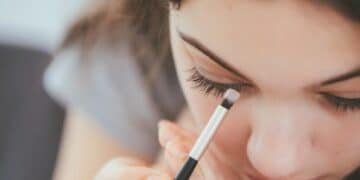Color Correcting Dark Circles: Your 2025 Expert Guide

Color correcting for dark circles involves using specific hues to neutralize discoloration under the eyes, creating an even skin tone and brighter appearance; this comprehensive guide provides updated techniques and product recommendations for achieving flawless results in 2025.
Tired of looking tired? Color Correcting for Dark Circles: A Comprehensive Guide for 2025 unveils the secrets to banishing those pesky under-eye shadows, leaving you looking refreshed and radiant. Get ready to master the art of color correction and reclaim your bright-eyed look!
Understanding Dark Circles: A Color Correction Primer
Dark circles are a common concern, but understanding their cause and color is essential for effective color correction. Different types of dark circles require different approaches, so let’s dive into the basics.
What Causes Dark Circles?
Dark circles can stem from various factors, including genetics, aging, lack of sleep, dehydration, and sun exposure. Identifying the primary cause is the first step to addressing them effectively.
Decoding the Colors of Dark Circles
Dark circles aren’t always just “dark.” They can appear in shades of blue, purple, brown, or even green. The underlying color dictates which color corrector to use.
- Blue/Purple Circles: Indicate thin skin and visible blood vessels.
- Brown Circles: Often a result of hyperpigmentation or sun damage.
- Greenish Circles: Can be caused by shadows or underlying skin conditions.
Remember, accurately identifying the color of your dark circles is crucial for selecting the right color corrector. This ensures you neutralize the discoloration effectively instead of exacerbating it.
By understanding the causes and colors of dark circles, you’re better equipped to tackle them with the right color correction techniques. This knowledge is the foundation for achieving a brighter, more even complexion under your eyes.
The Color Wheel: Your Guide to Color Correction
The color wheel is your best friend when it comes to color correction. It visually represents the relationships between colors, helping you choose the correct shade to neutralize unwanted tones.
Opposites Attract: Neutralizing Colors
The key to color correction lies in understanding that opposite colors on the color wheel neutralize each other. This principle is fundamental for effectively concealing dark circles.
Choosing the Right Color Corrector for Dark Circles
Based on the color wheel, here’s a breakdown of which color correctors work best for different types of dark circles:
- Peach/Orange: Ideal for blue or purple dark circles, especially on medium to deep skin tones.
- Pink: Works well for brightening blue/purple circles on fair skin tones.
- Yellow: Helps to neutralize purple or blue tones and brighten the under-eye area.
- Green: While less common for dark circles, it can help counteract redness around the eyes.

Experiment with different shades within these color families to find what works best with your skin tone and the specific color of your dark circles. Practice makes perfect!
Understanding the color wheel and the principle of complementary colors is essential for effective color correction. By choosing the right color corrector, you can create a flawless base for your concealer and achieve a brighter, more even complexion.
Best Color Correcting Products for 2025
The beauty market is constantly evolving, so here’s a look at some of the top color correcting products predicted to be popular in 2025, catering to various skin tones and preferences.
Cream Color Correctors: Rich and Blendable
Cream color correctors provide excellent coverage and are ideal for dry skin. They offer a natural-looking finish and can be easily blended with your fingers or a brush.
Liquid Color Correctors: Lightweight and Versatile
Liquid color correctors are lightweight and buildable, making them perfect for those who prefer a more natural look. They can be mixed with your foundation or concealer for a customized approach.
Stick Color Correctors: Precise Application
Stick color correctors offer precise application, allowing you to target specific areas of discoloration. They are also great for on-the-go touch-ups.
- Product Recommendation 1: A hydrating peach cream color corrector with SPF, perfect for medium skin tones.
- Product Recommendation 2: A lightweight yellow liquid color corrector enriched with antioxidants, suitable for all skin types.
- Product Recommendation 3: An orange stick color corrector with a creamy texture, ideal for deep skin tones.
When selecting a color correcting product, consider your skin type, the severity of your dark circles, and your desired level of coverage. Finding the right product is key to achieving a flawless and natural-looking result.
Staying updated with the latest color correcting products ensures you have access to the best tools for achieving a flawless complexion in 2025. Experiment with different formulas and shades to find your perfect match.
Application Techniques: Mastering the Art
Applying color corrector effectively is just as important as choosing the right product. Here are some essential techniques to help you master the art of color correction.
Prep Your Skin: Hydration is Key
Before applying any makeup, ensure your under-eye area is well-hydrated. Use a lightweight eye cream to prevent creasing and ensure smooth application.
Less is More: Start with a Thin Layer
Apply a small amount of color corrector to the darkest areas of your circles. Remember, less is more. You can always build up the coverage if needed.

Blending is Crucial: Achieve a Seamless Finish
Use a damp makeup sponge or a small blending brush to gently blend the color corrector into your skin. Focus on the edges to create a seamless transition.
- Technique 1: Use a stippling motion to press the color corrector into the skin for maximum coverage.
- Technique 2: Apply the color corrector in a V-shape under the inner corner of your eye and blend outwards.
- Technique 3: Set the color corrector with a lightweight translucent powder to prevent creasing.
Mastering these application techniques will elevate your color correction game and help you achieve a flawless, natural-looking finish. Practice and patience are essential for success.
With the right application techniques, you can effectively conceal dark circles and create a brighter, more even complexion. Experiment with different methods to find what works best for your skin and makeup routine.
Concealer Selection: Completing the Look
After color correcting, concealer is the final step to achieving a bright and flawless under-eye area. Choosing the right concealer is crucial for complementing your color correction efforts.
Choosing the Right Shade
Select a concealer that is one to two shades lighter than your skin tone. This will help to brighten the under-eye area and create a lifting effect.
Formulas and Finishes
Consider your skin type and desired finish when choosing a concealer. Creamy concealers are great for dry skin, while matte concealers are ideal for oily skin.
Application Techniques
Apply the concealer in a thin layer over the color corrector, focusing on the areas that need the most coverage. Blend gently with a damp makeup sponge or a concealer brush.
A well-chosen concealer will complement your color correction efforts and create a bright, flawless under-eye area. Pay attention to shade, formula, and application technique for optimal results.
By carefully selecting and applying your concealer, you can further enhance the effects of color correction and achieve a truly radiant and even complexion under your eyes.
Long-Term Solutions: Addressing the Root Cause
While color correcting is an excellent temporary solution, addressing the underlying causes of dark circles can lead to long-term improvements. Here are some lifestyle adjustments and treatments to consider.
Lifestyle Adjustments
Getting adequate sleep, staying hydrated, and protecting your skin from the sun can all help to reduce the appearance of dark circles. A healthy lifestyle is key to long-term skin health.
Skincare Ingredients
Look for eye creams containing ingredients like vitamin C, retinol, and peptides, which can help to brighten the under-eye area and improve skin elasticity.
Professional Treatments
If lifestyle adjustments and skincare aren’t enough, consider professional treatments like laser therapy, chemical peels, or fillers, which can address hyperpigmentation, thin skin, and volume loss.
Addressing the underlying causes of dark circles is essential for achieving long-term improvements. Combine color correction with a healthy lifestyle and targeted skincare for optimal results.
By focusing on long-term solutions in addition to color correction, you can achieve lasting improvements in the appearance of your dark circles and maintain a youthful, radiant look.
| Key Point | Brief Description |
|---|---|
| 🎨 Color Wheel | Use opposite colors to neutralize dark circles. Peach/orange for blue/purple. |
| 💧 Hydration | Always hydrate under-eye area before applying any product. |
| ✅ Less is More | Apply a thin layer of color corrector and build as needed. |
| ☀️ Sun Protection | Protect your under-eye area from the sun to prevent hyperpigmentation. |
FAQ: Color Correcting Dark Circles
▼
Color correcting involves using complementary colors to neutralize unwanted tones in the skin. For dark circles, this means using peach, orange, or yellow correctors to counteract blue, purple, or brown discoloration for a more even-toned base.
▼
Fair skin tones benefit from pink or light peach correctors, medium skin tones work well with peach or orange, and deep skin tones require orange or red-toned correctors. Consider the darkness of your circles too.
▼
While you *can*, it’s generally recommended to follow up with a concealer. The color corrector neutralizes the discoloration, and the concealer provides additional coverage and brightness for a seamless finish.
▼
To prevent creasing, start with a hydrated under-eye area, apply a thin layer of color corrector, and set it with a lightweight translucent powder. Avoid using too much product at once.
▼
While there aren’t direct natural substitutes, you can focus on improving dark circles holistically with better sleep, hydration, and eye creams with ingredients like vitamin C to brighten the under-eye area.
Conclusion
Mastering the art of color correcting for dark circles in 2025 involves understanding the color wheel, choosing the right products, perfecting your application techniques, and addressing the underlying causes. With this comprehensive guide, you’re well-equipped to achieve a brighter, more radiant under-eye area and confidently conquer any dark circle challenge.





